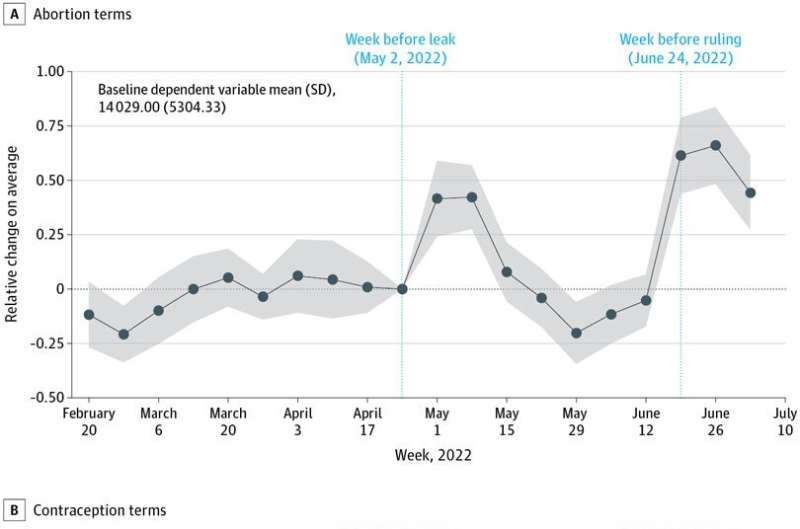This article has been reviewed according to Science X's editorial process and policies. Editors have highlighted the following attributes while ensuring the content's credibility:
fact-checked
peer-reviewed publication
trusted source
proofread
Internet search trends reflect concerns following Supreme Court health care decisions

Internet search trends may immediately capture how society seeks information related to reproductive health care, according to new research from Indiana University researchers.
The study, published today in JAMA Health Forum, analyzed internet searches for abortion- and contraception-related terms following the June 24, 2022, ruling by the United States Supreme Court on Dobbs v. Jackson Women's Health Organization. Researchers found that searches increased much more in states where reproductive health care access was more likely to be immediately restricted following the decision.
"It is still fairly early to see what will be the actual changes in reproductive health care access and utilization as a result of the Dobbs ruling, but Google search trends are often strong early predictors of subsequent health care access and utilization changes," said Sumedha Gupta, an associate professor of economics in the IU School of Liberal Arts at IUPUI and lead author on the study.
"The increase in abortion- and contraception-related internet searches following the decision may be an early indicator of greater concerns about impending restrictions in access to reproductive care among residents of states with trigger laws or pre-Roe bans relative to residents of states where reproductive access is protected."
Gupta and study co-authors Brea Perry, the Allen D. and Polly S. Grimshaw Professor in the IU Bloomington College of Arts and Sciences, and Kosali Simon, IU Distinguished Professor and Herman B Wells Endowed Professor in the O'Neill School of Public and Environmental Affairs, conducted a retrospective cross-sectional study of real-time Google search data from all 50 states and Washington, D.C.
They examined data for the weeks from Jan. 1, 2021, through July 16, 2022, and evaluated how abortion- and contraception-related searches changed following both the draft majority leak on May 2, 2022, and the final ruling on June 24, 2022.
The researchers found that searches for abortion-related terms increased from 16,302 to 75,746 per 10 million searches per week in each state with trigger laws or pre-Roe abortion bans during the weeks before and after the May 2 leak—42 percent higher than in states with laws protecting abortion access.
During the week of the June 24 ruling, searches increased to 150,602 per 10 million searches per week in states with trigger laws or pre-Roe abortion bans and 100,182 in other states—marking a 61 percent increase in search intensity in states where abortion access would be immediately restricted.
After the ruling, contraception-related searches also increased from 56,055 to 82,133 searches per week in each state where abortion bans were immediately in place, which is 25 percent more than in states that offered abortion protection.
"Further research would help understand if the increased search behavior seen here is related to searching for out-of-state health care, given this new difference in geography of reproductive health care access," Simon said.
According to the researchers, this study could be used to inform ongoing policy decisions about abortion access and care, and it shows that internet-based information dissemination about reproductive health care could serve as a viable strategy to inform public health decisions in the future.
More information: Sumedha Gupta et al, Trends in Abortion- and Contraception-Related Internet Searches After the US Supreme Court Overturned Constitutional Abortion Rights, JAMA Health Forum (2023). DOI: 10.1001/jamahealthforum.2023.0518


















